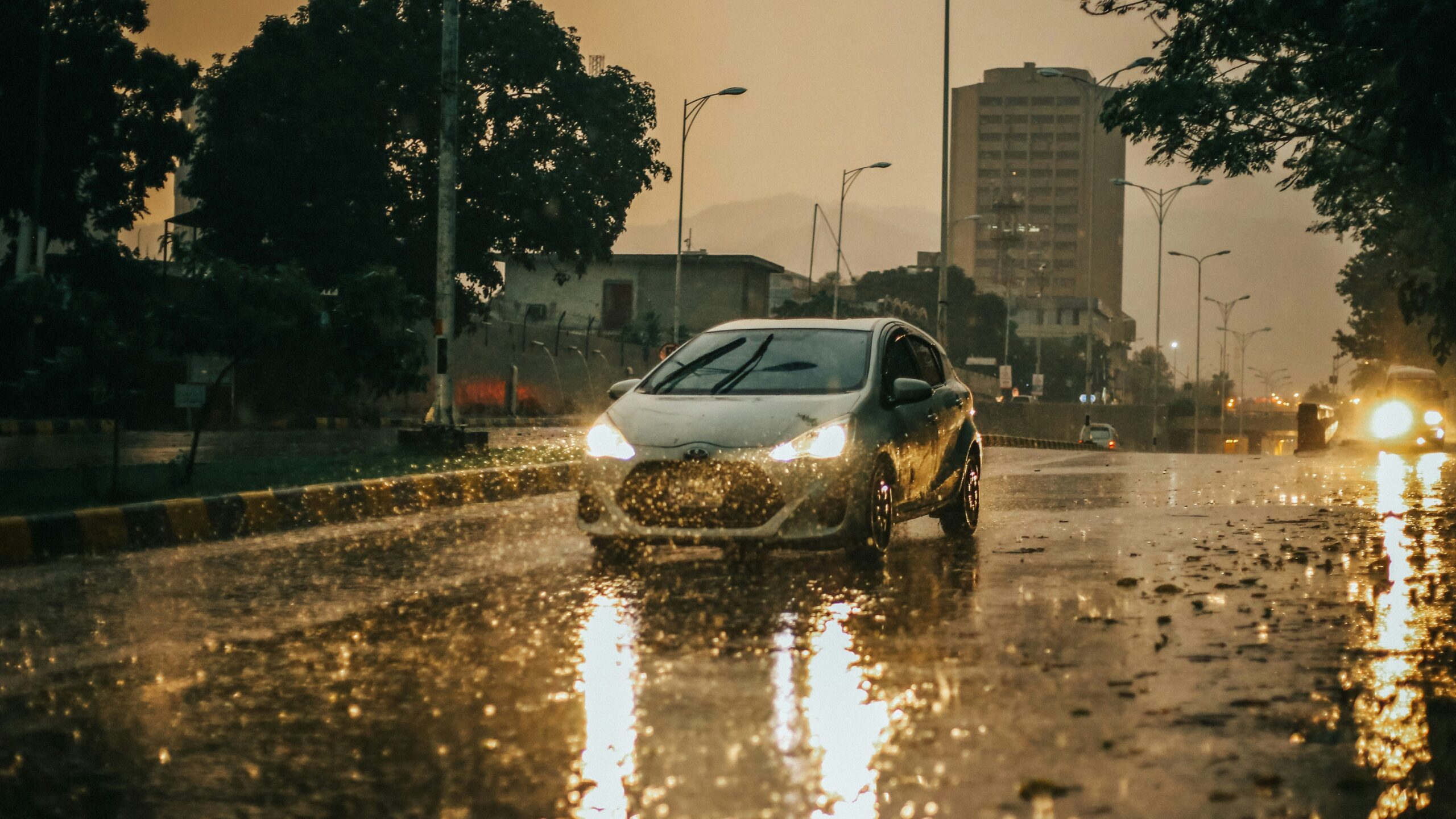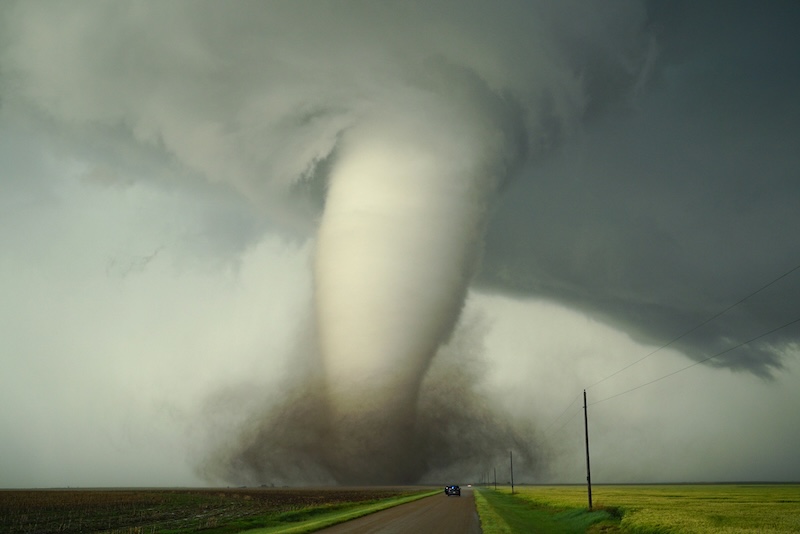Does Car Insurance Cover Natural Disasters?
Yes, but only if you have comprehensive coverage.

Yes, but only if you have comprehensive coverage.

Good news: When you include comprehensive coverage on your car insurance policy you’re protected against damage caused by natural disasters—like hurricanes, floods, wildfires, or hailstorms.
Let’s take a look at how car insurance can help protect your car against different types of natural disasters.
Yes. If your car gets damaged from a natural disaster—whether it’s a hurricane, tornado, or just a run-of-the-mill thunderstorm—your car insurance policy can help manage the costs in a few different ways:
Comprehensive coverage helps with repairs and replacements caused by things that aren’t accidents, like vandalism, theft, or damage from natural disasters. The coverage amount is based on the car’s ACV (actual cash value) in the event of a total loss, and is subject to your deductible, usually between $100 and $1,000. ACV is the car’s value at the time of loss, factoring in depreciation. The formula? ACV = Replacement cost minus depreciation (the loss of value over time from wear and tear).
Keep in mind that comprehensive coverage isn’t always part of a standard car insurance policy—it’s optional. That said, if you’re leasing or financing your car, your lender might require you to have it.
Temporary transportation coverage can help pay for alternative transportation methods while your car’s in the shop after a covered natural disaster incident. At Lemonade, pretty much any type of transportation is covered for up to a month while you’re waiting on repairs (as long as the reason for your car repair is covered). You have a daily limit and can use the money to help with the costs of rideshares, rental cars, or even public transport like buses and trains.
Yes. Whether your car gets damaged in a regular thunderstorm or something more intense like a hurricane, comprehensive car insurance has you covered. It protects against things like flooding, falling trees or branches, hail damage, and more.
Yes. Flood damage is included under comprehensive coverage. Whether it’s from overflowing rivers, heavy rains, or storm surges, this protection makes sure you’re not left footing the bill for waterlogged interiors or engine damage caused by flooding.
Flooding may be more of a risk than you think. CARFAX estimates that around 347,000 cars were damaged by flooding in 2024, with 89,000 of those coming from smaller storms over the summer months.
Yes. Hurricane damage is covered under comprehensive car insurance. This includes wind damage, falling debris, and even flooding caused by the storm.
Imagine you don’t have a garage so your car’s parked outside during a hurricane, and a huge tree branch falls on your car, smashing your windshield and denting the roof. You get your car towed to a local repair shop and the total damage comes out to $5,000. Luckily, you have comprehensive coverage with a $500 deductible, and in this hypothetical scenario your claim is approved. After paying your $500 deductible, your insurer pays you $4,500 for the damage.
In the US, hurricane season runs from June 1st to November 30th each year and can cause serious damage to cars. CARFAX reports that Hurricane Helene damaged 138,000 cars across multiple states, while Hurricane Milton added another 120,000 damaged vehicles in Florida during the 2024 hurricane season. Hurricanes can do serious damage to your car, which is why having comprehensive car insurance is so important to keep it protected.

Yes. Tornadoes can wreak havoc on your car, but comprehensive insurance has you covered. If high winds, flying debris, or even a fallen tree during a tornado damages your car, your policy can help with repairs, or even replacement if the car is totaled.
Yes. Comprehensive car insurance covers hail damage. Whether it’s a few dents or significant damage caused by golf ball-sized hailstones, this type of coverage can help cover the cost of repairs and give you peace of mind when the unexpected hail storm hits.
NOAA recorded 5,373 hail events across the US in 2024, with Texas and Kansas getting hit the hardest. May was the busiest month for hail, with 1,870 events recorded. That’s just one of the many reasons it’s important to protect your car with comprehensive coverage.
Yes. Fire damage—whether caused by a wildfire or accidental fire—is covered under comprehensive insurance. Fixing or replacing a vehicle after a fire can get pricey, but this coverage helps take the financial stress off your shoulders in those situations.
Yes. Comprehensive coverage covers car damage caused by landslides.
Picture this: You park your car at the bottom of a hill, and after a night of heavy rain, part of the slope collapses, leaving your car buried in mud and debris. You manage to get it out and towed to the repair shop, but your insurer declares it a total loss. The good news? You’ve got comprehensive car insurance with a $250 deductible. In this hypothetical scenario, your claim gets approved, and your insurer determines your car’s ACV is $15,000. After the $250 deductible, they pay you $14,750 to replace your car.
Landslides usually happen because of heavy rain, earthquakes, or other natural disasters—but that’s not always the case. According to the USGS, some landslides give you clues or warnings beforehand, while others can happen out of nowhere with no warning at all. They can also happen anywhere in the US, making them one of the most dangerous natural disasters out there.
Car insurance doesn’t cover natural disasters when comprehensive coverage isn’t included in your policy. For instance, if you only have liability coverage—the basic requirement in most states—it won’t cover damage to your own vehicle. Liability insurance is designed to pay for damages you cause to others, like another driver’s repair costs if you’re at fault in an accident, but it doesn’t extend to your own car.
Negligence (aka, something you did that possibly led to the damage) is usually excluded—even if you have comprehensive coverage. For example, if you leave your sunroof open during a rainstorm, and the rain damages the interior of your car, it probably won’t be covered.
You’re usually able to adjust your coverage during your policy period, but most insurers put restrictions or waiting periods in place when severe weather, like a hurricane, is on the way. This means you can’t make changes to your policy or buy new coverage right before a storm hits. To stay prepared, it’s smart to keep comprehensive coverage all year round.
This keeps you covered for any unexpected emergencies, like damage from bad weather, theft, or other surprises that could hit your wallet hard.
You’ll typically be able to add comprehensive coverage to your car insurance policy after a natural disaster. However, any damage that happened before your comprehensive coverage went into effect would not be covered.
Protecting your car from natural disasters requires a mix of preparation and smart decisions. Here are some practical tips to help minimize potential damage:
Here are some steps you can take to get back on the road if your car gets damaged by a natural disaster:
At Lemonade, we designed our digital claims process to be as quick and easy as possible. Just submit your claim through the app with the help of our chatbot, AI Jim. We’ll pair you up with one of Lemonade Car’s claims adjusters to help you with the rest of the process.
Knowing how car insurance handles natural disasters can save you a lot of hassle, time, and money after extreme weather hits. Adding comprehensive coverage to your policy means your car is covered for unexpected damage from things like hailstorms, floods, or wildfires.
Don’t wait for disaster to strike, get your free quote today.
No, home insurance does not cover your vehicle. Comprehensive car insurance is required for natural disaster-related car damages.
Yes, your car insurance will pay for damages caused by a tree falling on your car if you have comprehensive coverage. After paying your deductible, your insurance will cover the repair or replacement costs.
A few quick words, because we <3 our lawyers: This post is general in nature, and any statement in it doesn’t alter the terms, conditions, exclusions, or limitations of policies issued by Lemonade, which differ according to your state of residence. You’re encouraged to discuss your specific circumstances with your own professional advisors. The purpose of this post is merely to provide you with info and insights you can use to make such discussions more productive! Naturally, all comments by, or references to, third parties represent their own views, and Lemonade assumes no responsibility for them. Coverage and discounts may not be available in all states.
Please note: Lemonade articles and other editorial content are meant for educational purposes only, and should not be relied upon instead of professional legal, insurance or financial advice. The content of these educational articles does not alter the terms, conditions, exclusions, or limitations of policies issued by Lemonade, which differ according to your state of residence. While we regularly review previously published content to ensure it is accurate and up-to-date, there may be instances in which legal conditions or policy details have changed since publication. Any hypothetical examples used in Lemonade editorial content are purely expositional. Hypothetical examples do not alter or bind Lemonade to any application of your insurance policy to the particular facts and circumstances of any actual claim.